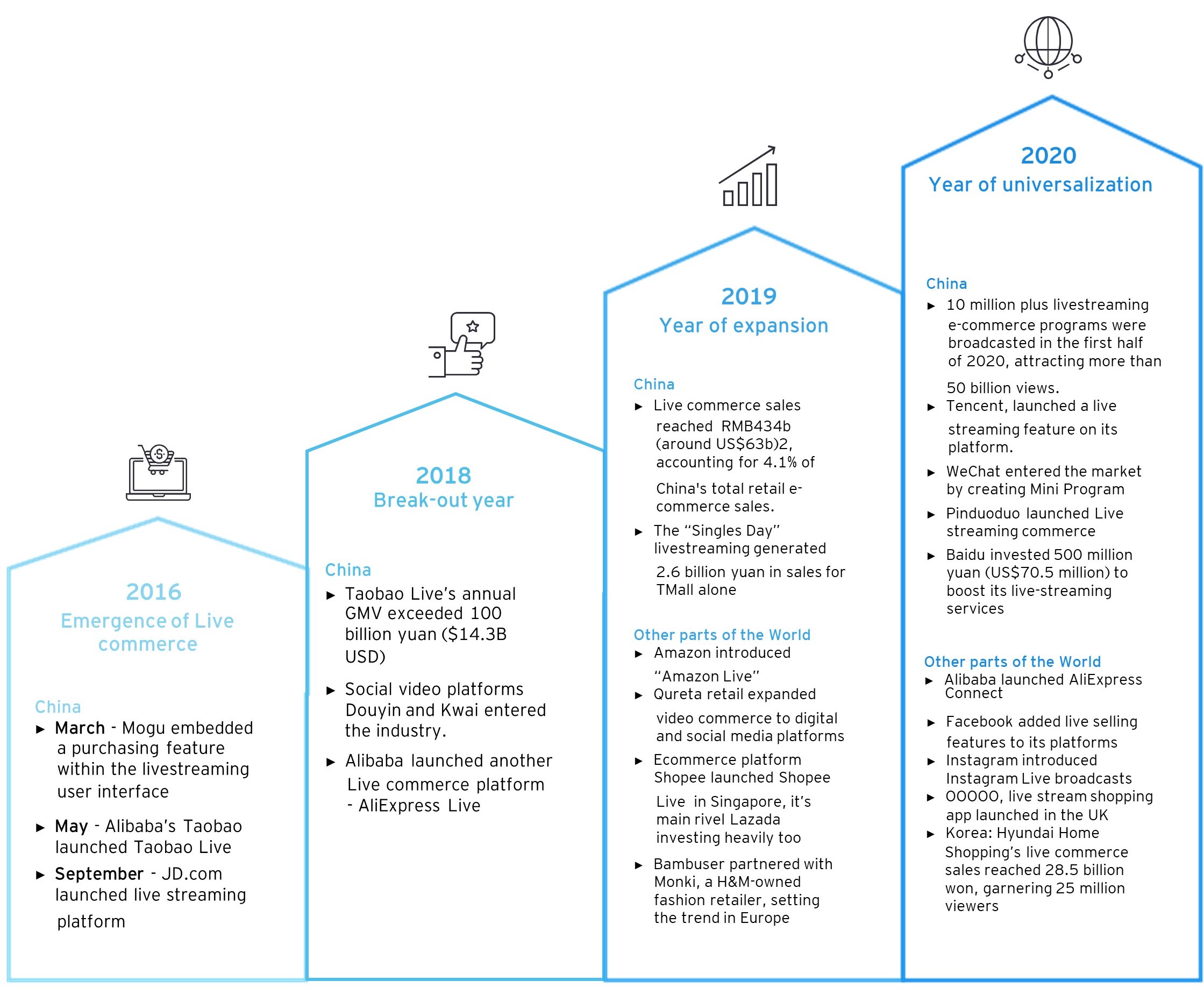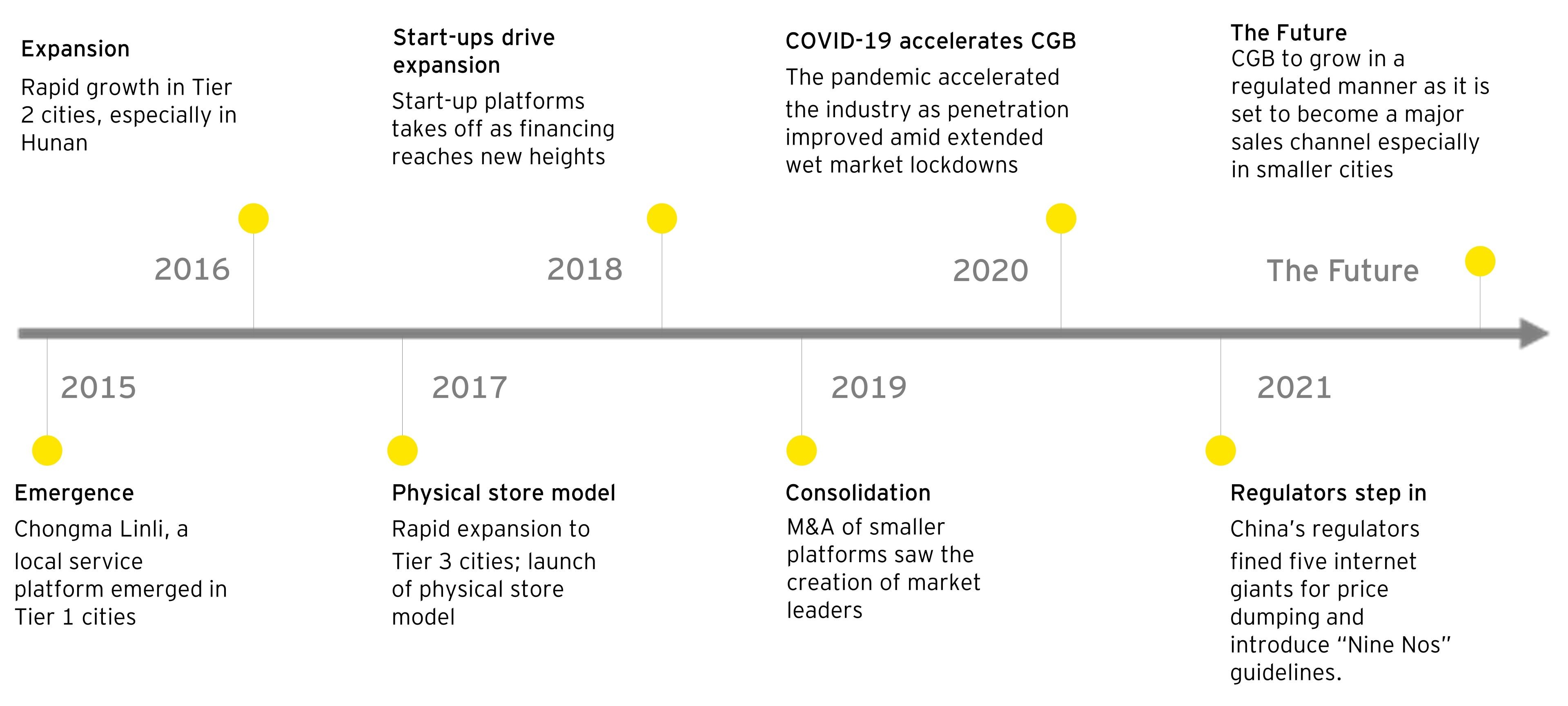
Chapter #1
Live commerce
The explosion of live commerce in China
With China leading the world on digital adoption and data usage, it is of little surprise that e-commerce is leading in defining new ways of shopping and buying. This means that the rest of the world took note as live commerce began to make inroads in China. Live commerce (defined as live video streaming and e-commerce shopping services wrapped in one platform) enables consumers to log into an e-commerce website or social media channel and make real-time purchases while watching live demos and interacting with the host. The concept began in March 2016, when MOGU, a social media fashion content provider, embedded a shopping feature within its livestreaming interface, allowing customers to purchase while watching live content.
What started as an experiment to interact with consumers in a live show has transformed into a multi-billion-dollar industry in the space of few years. In early 2020, live commerce was set for solid growth which COVID-19 accelerated it. People in lockdown went online, spending time on social media and live streaming, while limited access to physical stores drove online shopping. By combining shopping and leisure, live commerce created an interactive at-home shopping experience for consumers. Data from China's Ministry of Commerce shows that over 10m livestreaming e-commerce programs were broadcast in the first half of 2020, generating over 50b views³. Taobao Live, which has a live commerce market share of around 80%⁴, generated over RMB400b (US$61.7b)⁵ in GMV in 2020.
Despite rapid growth, live commerce still accounts for less than 10% of China's retail e-commerce market. But with consumers growing in confidence, it has significant upside potential. According to the latest FCI survey⁶, 42% of respondents in China have already purchased through live broadcast, and 66% of the respondents are either satisfied or extremely satisfied with their live broadcast shopping experience. By 2021, all the major e-commerce platforms and social media channels had already jumped on the live commerce bandwagon.
A channel primed for further growth
The key enabler for live commerce is China’s integrated digital infrastructure. China has surpassed the world in digital development and adoption, especially in e-commerce and cashless payment. In the latest FCI survey, 77% of Chinese consumers responded that they expect that their experience of using technology will only improve in the future compared with the global average of 65%, while 71% of them intend to go cashless in the future.
The interoperability of e-commerce, social media and payment platforms enables seamless live shopping experiences in which users can engage with sellers and make purchases in real time without having to exit the stream they are watching. High levels of aftersales services such as quick and low-cost delivery, efficient returns management and effective handling of complaints have also bolstered trust in live commerce.
Another differentiating factor is that live commerce benefits from is its own network of influencers known as Key Opinion Leaders (KOLs), the most successful of whom have reached celebrity status. KOLs can transform a live stream into something that is engaging and entertaining. By elevating shopping experience, KOLs also drive sales making them highly sought after. Top influencers like Austin (Jiaqi) Li and Viya Huang can attract more than 35m viewers and generate millions in sales⁷.
As well as the growth of live commerce channels, there are further strategic benefits that they can bring. These include conversion rates that are six times higher than conventional marketing⁸, high levels of traffic generation (driving other revenue and brand opportunities), and options for smaller merchants to reach a broader audience with less investment. Additionally, many brands and retails often used live commerce platforms to clear excess inventory in bulk by offering discounts. However, many companies have gradually shifted toward a more holistic value creation strategy through product and channel differentiation.
Fast growth comes with pain points
Live commerce is promising, but challenges to the channel remain, particularly in achieving profitability and navigating mounting regulation. Despite overall growth, some companies face considerable margin challenges driven by high return rates and production costs. To drive up sales and viewer numbers, KOLs often negotiate with brands to offer substantial discounts on products or services for their shows. A lot of effort and money go into broadcasting a successful live commerce session. These factors cost money, and, when combined with the cost of returns and risk of unsuccessful live stream margins can suffer. Rapid growth has also increased misuse of the live commerce channel, forcing regulators to step in to curb malpractice and issue guidelines to improve measures.
The world is catching up
COVID-19 related lockdowns boosted shoppable streaming around the world encouraging global companies and platforms to join the movement, but live commerce outside China remains nascent. Digital infrastructure and shopping ecosystems in other countries are less integrated than in China and consumers are more resistant to new ways of shopping. The US live commerce market was estimated to be worth around US$6b in 2020⁹, less than one-tenth of China’s live commerce market. However, the trend is catching up, just as China reached a tipping point, so too would other countries in the coming few years.
Figure 3 Live commerce development timeline


Chapter #2
Community group buying
A fast-growing phenomenon
As live commerce moves to the mainstream, another fast-growing trend in China is approaching its own tipping point. Community group buying (CGB), which allows communities to collectively buy products through platforms, is a fast-growing phenomenon, particularly in lower tier cities. According to the FCI survey¹⁰, 67% of Chinese consumers have either made a purchase via CGB or are familiar and agree with the business model. CGB connects sellers with community groups who pool their buying power into bulk orders of essentials such as fresh food and groceries to drive down prices and delivery costs. The model leverages “mini-apps” within established platforms such as WeChat. Typically, a community leader (usually well-known figures to the local community such as shopkeepers) maintains a WeChat group of up to 500 local members. Orders are placed with the community leader through mini-apps. Once collective demand reaches a certain level, the order is confirmed with the platform and delivered in bulk to the community leader who distributes individual orders and acts as point of contact to resolve disputes with sellers.
The origins of CGB can be traced back to 2015, when Chongma Linli, a community based local service platform focusing on Tier 1 cities emerged, but CGB quickly caught up in other cities with consumers finding the services beneficial, cost effective and timely. The year 2018 saw a surge of start-ups and attracted the attention of larger players looking for new market opportunities. Start-ups and existing platforms successfully raised funds to expand operations, driving a wave of consolidation which saw the emergence of several regionally dominant players. During Covid-19, restrictions to movement and fear of infection drove a surge in demand, especially fresh food, through CGB platforms. The value of CGB sales is expected to grow to RMB1.5t (US$231.7b) in 2021 and RMB5t (US$ 771.5b) by 2025¹¹.
Figure 4 Consumer group buying timeline

A direct and far-reaching service model
Weaker e-commerce penetration and poor last mile logistics in lower tier cities have traditionally constrained opportunities to apply models that might work in Tier 1 cities. CGB has helped platforms overcome these challenges by opening doors to previously untapped markets. High conversion rates, short repeat order cycles, demand consolidation and coordination by community leaders have delivered rapid growth. Moreover, CGB eliminates the middleman in the fresh food value chain and connects the consumer to the farmer through the platform. This benefits the farmers who enjoy better prices and direct access to consumers, and the consumers enjoy lower prices that are not marked up significantly. The size of the market makes it attractive for larger players and start-ups to meet unmet demand by adapting existing channels and platforms rather than creating new ones.
Uneven demand presents challenges
While the benefits are clear, not all community groups are equally profitable or active. Providers need to ensure a minimum amount of repeat business to ensure profitability, which requires scale to deliver margin and growth. If these requirements are not met quickly, the service falters. Platforms try to overcome this challenge by mandating minimum order quantities, but another challenge comes from a combination of low quantities and low geographical concentration which increases warehousing and distribution costs and complexity.
Platforms are trying to improve operations in lower tier cities, where supply chains and logistics are less developed. However, low levels of automation in processing orders can lead to higher error rates which undermine efficiency and drive up costs. Additionally, infrastructure challenges like inadequate cold chains and outdated warehousing in lower tier cities require investment. Competition is also accelerating. Low barriers to entry attracted start-ups, but established platforms are upping the ante by applying deep discounts and acquiring community leaders. This is driving consolidation, especially as loss-leading incentives are being aggressively pursued by some platforms to drive out smaller players.
As a result, local vendors can find it difficult to compete and some of these practices have been brought to the attention of regulators. China’s State Administration for Market Regulation (SAMR) imposed large fines in March 2021¹² on leading platforms for price dumping. The “Nine No’s”¹³, jointly introduced by the SAMR and the Ministry of Commerce along with anti-monopoly guidelines for internet platforms will impact the market expansion strategies of larger platforms.
Summary
China was however already leading the world in digital behavior because of its integrated digital infrastructure that has enabled cashless transactions and the integration of social and shopping platforms into a single customer experience. As live commerce and community group buying become more mainstream in Chinese shopping culture, the rest of the world will be watching to see how this will ultimately shape the habits of global consumers.




